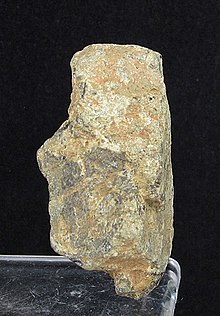Polycrase
Appearance
| Polycrase | |
|---|---|
 Polycrase crystal from Rio Pomba, Minas Gerais, Brazil | |
| General | |
| Category | Mineral |
| Formula (repeating unit) | (Y,Ca,Ce,U,Th)(Ti,Nb,Ta)2O6 |
| IMA symbol | Plc[1] |
| Identification | |
| Mohs scale hardness | 5-6 |
| Specific gravity | 5 |
| Other characteristics | |
Polycrase or polycrase-(Y) is a black or brown metallic complex uranium yttrium oxide mineral with the chemical formula (Y,Ca,Ce,U,Th)(Ti,Nb,Ta)2O6. It is amorphous. It has a Mohs hardness of 5 to 6 and a specific gravity of 5. It is radioactive due to its uranium content (around 6%). It occurs in granitic pegmatites.
Polycrase forms a continuous series with the niobium rich rare earth oxide euxenite.
It was first described in 1870 at Rasvag, Hidra (Hittero) Island, near Flekkefjord, Norway. It is found in Sweden, Norway, and the United States.
References[edit]
- ^ Warr, L.N. (2021). "IMA–CNMNC approved mineral symbols". Mineralogical Magazine. 85 (3): 291–320. Bibcode:2021MinM...85..291W. doi:10.1180/mgm.2021.43. S2CID 235729616.
